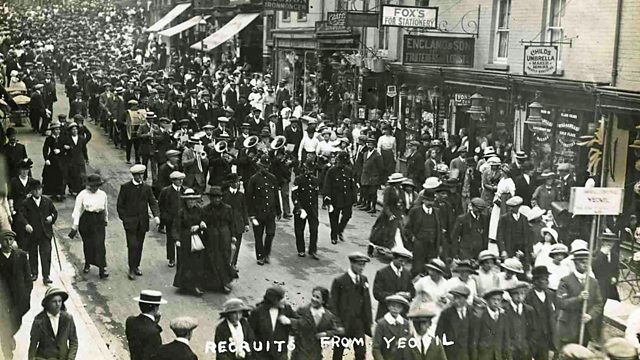Yeovil, Somerset: Marching to War
The remarkable diary of a Yeovil woman
Market day in Yeovil is bustling and noisy. Twice a week stalls overflow with food, clothes and household goods attracting eager shoppers to the town centre.
Traders have been selling their wares like this in Yeovil for hundreds of years. But even on the busiest market days the picture in the heart of this ancient Somerset town doesn't even come close to the crowded scene which greeted onlookers in August 1914.
When Britain went to war the men of Yeovil responded with enthusiasm and in large numbers. A series of remarkable images from the time prove the significance of the 'call to arms' to local families. In museums and photographic archives throughout the UK there are countless collections of regimental portraits, battalion group shots and scenes from the Western Front. But informal snaps of men marching off to war are much harder to find. So a series of pictures showing new recruits in civvies marching through Yeovil is a fascinating glimpse in to the past.
The men are pictured heading to the town railway station and waiting on the platform for trains that would take them off to war. The streets are teeming with people cheering and waving while several shots include a hand-held placard with the message: 'Well done Yeovil. We are proud of you'. A brass band accompanied the recruits while a man in his Sunday best and a boater hat can be seen beating time on a bass drum. There's an official guard of smartly dressed police officers and a horse escort which adds to an obvious air of excitement and an almost carnival-like atmosphere.
Clare Robinson has a passion for local history and knows the importance of the photographs: βThe townsfolk all look so excited in these pictures. Only in hindsight do we know that actually the men were heading for hell on earth. We'll never know how many of them didn't come back."
Clare helps run the Community Heritage Access Centre on the outskirts of Yeovil. It's an Aladdin's cave of documents, artwork, costumes, coins and memorabilia which tell the story of the town back to Roman times. But it's these revealing photographs from the start of World War One which seem to fascinate her the most.
The images of the recruits' march provide a valuable insight in to the way local people reacted to events in the summer of 1914. But they're complimented by another treasure in the archives.
Louisa Harris was Yeovil born and bred and in her early fifties when war broke out. For most of her adult life she wrote a diary and her observations on local and national events are an enlightening commentary on the social history of the late Victorian and early Edwardian era. Louisa was in the town when the new recruits gathered in the Borough before they marched down Middle Street, in to South Western Terrace and on to the station. It's the only first-hand account of that bitter-sweet day to have been unearthed in the hundred years since.
On the whole her diary entries for 1914 and 1915 reveal anxiety about the outcome of the conflict and the effects the fighting was having on life in South Somerset.
A century on, historians are still debating whether the massive number of new recruits was due to national pride, civic duty, jingoism or simply peer pressure and a heady rush to see a "skirmish or two" in the mistaken belief that it would all be over by Christmas. Whatever the motivation, Clare Robinson is thankful that evidence of that remarkable event has survived: "We're lucky to have this unique record of photographs and Louisa's diary. Without them we'd never know about the day the men of Yeovil marched off to war".
Location: Lower Middle Street, Yeovil, Somerset BA20 1LT
Image shows the men marching through Lower Middle Street towards the train station, ready for war. Photograph courtesy of the Community Heritage Access Centre
Presented by Clare Robinson of the Community Heritage Access Centre
Duration:
This clip is from
Featured in...
![]()
Recruitment & Training—World War One At ΒιΆΉΤΌΕΔ
How the army prepared the nation for conflict
![]()
ΒιΆΉΤΌΕΔ Somerset—World War One At ΒιΆΉΤΌΕΔ
Places in Somerset that tell a story of World War One
![]()
ΒιΆΉΤΌΕΔ Front Life—World War One At ΒιΆΉΤΌΕΔ
Everyday life in the towns, villages and countryside
More clips from World War One At ΒιΆΉΤΌΕΔ
-
![]()
The loss of HMY Iolaire
Duration: 18:52
-
![]()
Scotland, Slamannan and the Argylls
Duration: 07:55
-
![]()
Scotland Museum of Edinburgh mourning dress
Duration: 06:17
-
![]()
Scotland Montrose 'GI Brides'
Duration: 06:41







